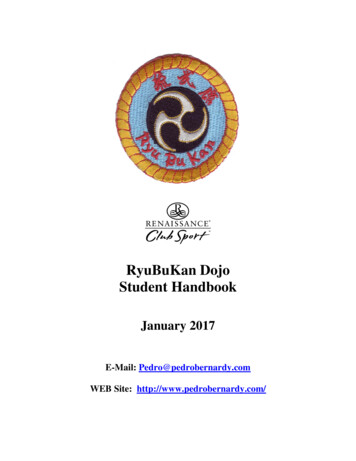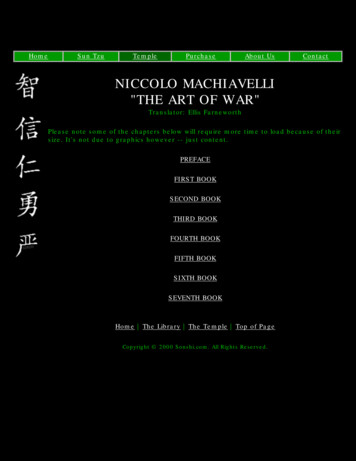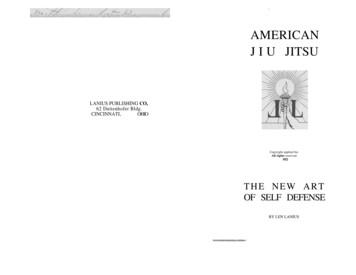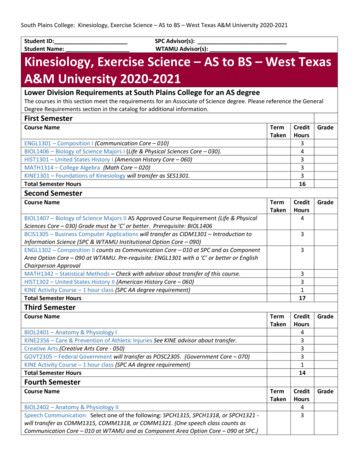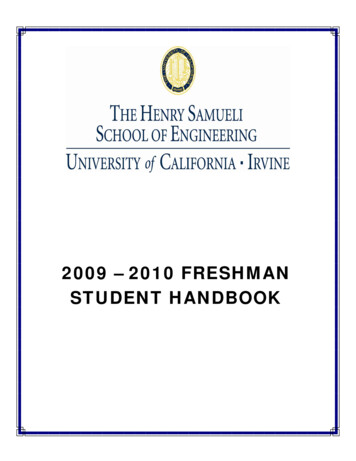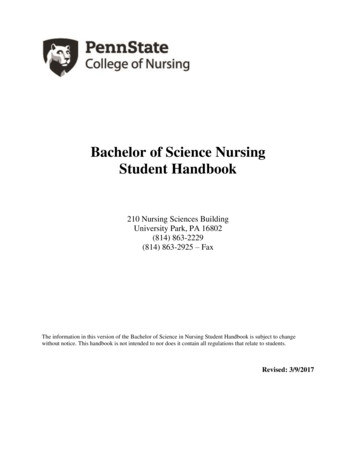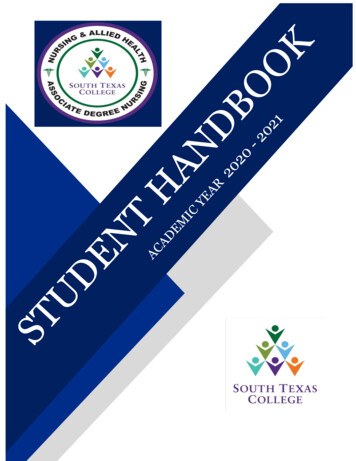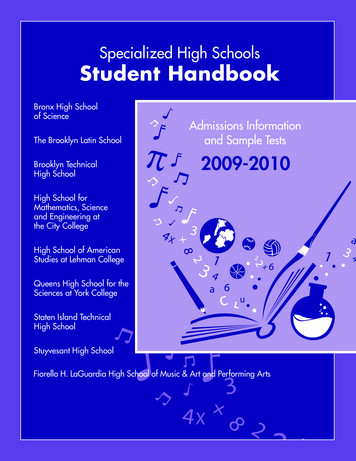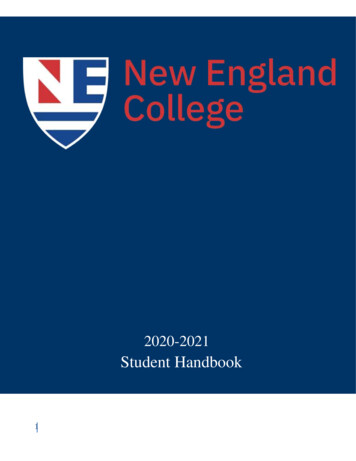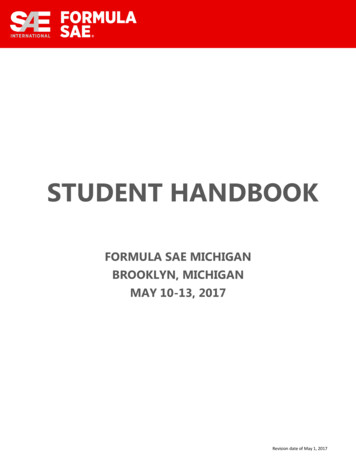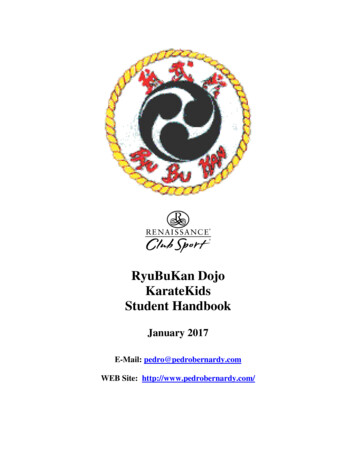
Transcription
RyuBuKan DojoKarateKidsStudent HandbookJanuary 2017E-Mail: pedro@pedrobernardy.comWEB Site: http://www.pedrobernardy.com/
RyuBuKan DojoStudent Handbook1.0 Table of Contents1.0 Table of Contents 22.0 Introduction: Dojo and Instructor 42.1 The RyuBuKan Dojo 42.2 Instructor's Resume: Pedro J. Bernardy 5Please complete and return to your instructor at next class meeting 62.3 Registration Form 73.1 Shorin-Ryu Karate 83.2 Kobudo 83.3 Small Circle Jujitsu 84.0 General Rules & Information 94.1 Class Times: 94.2 Class Location: 94.3 Class Fees: 94.3 How to Tie Your Belt: 105.0 Dojo Etiquette 116.0 Ranking System & Requirements: KarateKids Ages 5 to 8 126.1 Yellow Belt 1st Degree Requirements 146.2 Yellow Belt 2nd Degree Requirements 156.3 Yellow Belt 3rd Degree Requirements 166.4 Orange Belt 1st Degree Requirements 176.5 Orange Belt 2nd Degree Requirements 186.6 Orange Belt 3rd Degree Requirements 196.7 All Ranks Above Orange Belt 207.0 Martial Arts Terminology/Dictionary 21Counting 21A 21B 21C 22D 22E 22F 22G 22H 232 of 35RyuBuKan DojoKarateKids Student Handbook
RyuBuKan DojoStudent HandbookI 23J 24K 24L 25M 25N 25O 26P 26Q 26R 26S 27T 27U 28V 28W 28X 28Y 28Z 298.0 Student Contributions: Research, Articles of interest, etc. 308.1“The Endless Path” - contributed by Pedro Bernardy 303 of 35RyuBuKan DojoKarateKids Student Handbook
RyuBuKan DojoStudent Handbook2.0 Introduction: Dojo and Instructor2.1 The RyuBuKan DojoMission Statement: To promote the arts and culture of Okinawa, particularly those related to themartial arts; to embrace all other cultures and their indigenous methods of self-defense; to provide asafe, effective, and enjoyable experience for a lifetime study of martial arts.Dojo History: The RyuBuKan Dojo was established by Pedro J. Bernardy as a means for giving backto his instructors and their arts. The name Ryu Bu Kan is formed from the Ryukyu culture fromwhich the basis of our studies originate (RYU), the expression of martial art as a way of life (BU), anda home for all who wish to learn and share from these efforts (KAN). The RyuBuKan Dojo is afamily affair where lessons are earned by consistent effort and positive attitude. Students come and gobut our hope is that the strength and sincerity learned here will carry them through all of life'schallenges.Curriculum (KarateKids): Students from age four years to eight years of age receive instruction inbasic self-defense techniques and safety awareness. Lessons consist of practice of basic strikes andblocking techniques, role-playing scenarios, and lectures on practical safety tips. Students also learnfundamental lessons on the cultural aspects of our martial arts, including basic Japanese grammar usedduring class to provide a complete experience and appreciation of their lessons. Parents and guardiansare encouraged to observe and participate in each class to enhance their understanding of this training.Curriculum (Traditional): Students above the age of eight years receive instruction in OkinawanKarate, ancient weapon arts known as Kobudo, and basics of Small Circle Jujitsu. Our Karate practiceis based on a curriculum of technique from Okinawan styles known as Shuri-Te, Naha-Te, andTomari-Te from the areas on the island of Okinawa where these techniques were developed. Jujitsubasics taught in the RyuBuKan Dojo are from Jim Silvan Sensei and his teacher, Professor Wally Jay,founder of Small Circle Jujitsu. There are two systems of Kobudo practiced in our studio; MatayoshiFamily style as taught by Kimo Wall Sensei and his teacher, Matayoshi Shinpo Sensei, and YamaniRyu as taught by Silvan Sensei and his teacher, Oshiro Toshihiro Sensei.4 of 35RyuBuKan DojoKarateKids Student Handbook
RyuBuKan DojoStudent Handbook2.2 Instructor's Resume: Pedro J. BernardyI began formal martial arts training in 1973 in my home town of Reading, Pennsylvania at the age oftwenty with George Dillman in the style known then as Okinawan Kempo Karate. My initial desirewas to acquire the incredible skills I witnessed from my teachers coupled with a practical need todefend myself. I soon learned that it requires much more skill to keep from fighting, and that themartial arts are intended as a life-long endeavor.I continued my training after moving to Chicago in 1974. The studio was the Ali Kai Academy inMaywood, Illinois, where I was taught the basics of Shuri-Ryu karate. My teachers were students ofRobert Trias, including Bill and Bernice Downs, who conducted classes that required no less than100% commitment. These were serious, hard-hitting sessions that I believe are seldom seen in today'scommercial dojo setting. Unfortunately the Ali Kai Academy closed just a few months of my joiningdue to the sudden death of its founder, Pat Wyatt. For the next two years I studied Chinese Kenpo in alocal studio of the Tracy Brothers system and practiced what I could with friends and family.In 1976 I moved to California where by a stroke of great fortune met several martial art leaders of theOkinawan community in Los Angeles. Among these special individuals are Takushi Yasukazu,Oyakawa (Roy) Shogen, Kimo Wall, and Kenneth L. Penland. These teachers showed me the beautythat is Ryukyu culture with its folk dance and music, proud history, and many other treasurespreviously unknown to me. I will be forever in their debit for what they shared. The RyuBuKan Dojois a small measure of payment for their contributions to the martial arts and to me personally. In 2003,I entered the Health and Wellness industry as a personal trainer and lifestyle coach to enable me a fulltime opportunity to teach the importance of leading a balanced way of life through a healthy mind,body and spirit.After gaining black belt ranking in Okinawan arts I sought to gain a greater appreciation of relateddisciplines. I studied Japanese Karate, Jujitsu, Calligraphy, Tea Ceremony and language. I have alsotrained in martial arts from other cultures including Kenpo, Tae Kwan Do, Tang Soo Do, Eskrima andTai Chi Chuan. Since 1991, I have taught and trained in Northern California, both privately and in thepublic sector. My students come in all ages and levels of martial arts experience. I continue my owntraining primarily with Jim Silvan, and with mentors that have included Oshiro Toshihiro, ProfessorWally Jay, Matayoshi Shinpo, Nakamura Yoshio, and Shinzato Katsuhiko. Beginning in 2010, I beganserious study of Chinese martial arts to learn more about the origins and influences on the Okinawanarts I teach.Of all the many benefits I have thus far derived from my training, it is the support and involvement ofmy wife, Junko, daughters and students Julia Ai and Christina Machiko, and the members of theRyuBuKan Dojo that provide me the most sense of accomplishment.5 of 35RyuBuKan DojoKarateKids Student Handbook
RyuBuKan DojoStudent HandbookSTUDENT REGISTRATION FORM (SEE NEXT PAGE)Please complete and return to your instructor at next class meeting6 of 35RyuBuKan DojoKarateKids Student Handbook
RyuBuKan DojoStudent Handbook2.3 Registration FormRyuBuKan DojoRegistration FormStudent Name: Age:Address: City: Zip:Parent's Names (if under 18):Telephone: Home: Work:E-mail Address:Previous martial arts experience:I, the undersigned student, parent or legal guardian of the student described above, recognize that the studyof martial arts involves physical exertion and potential contact that could result in injury. By signing thisregistration form I release all liability and claims against the RyuBuKan Dojo and agree to hold harmlessany liability against the RyuBuKan Dojo, any sponsoring organization, facility, instructor, and any otherparty involved, due to any injuries, accidents, negligence, or other circumstances arising from participationin the RyuBuKan Dojo training program at any time prior, during and after class times.Student Signature:(Parent or legal guardian if under 18)Date:STUDENT REGISTRATION FORM (SEE PREVIOUS PAGE)Please complete and return to your instructor at next class meeting7 of 35RyuBuKan DojoKarateKids Student Handbook
RyuBuKan DojoStudent Handbook3.0 Martial Arts History3.1 Shorin-Ryu KarateShorin-Ryu Karate developed from a combination of indigenous Okinawan fighting art and Chinese martial arts,and is regarded as one of the three major schools of Okinawan karate. The style was originally termed “ShuriTe” or “Hands of Shuri”, where the principal kingdom of the Ryukyu Islands resided, and was practiced secretlyfor generations while Okinawa was ruled by the Japanese. It was in the late 1800's that Shuri-Te began to becalled Shorin-Ryu, a reference to the arts' roots at the Shaolin temple in China (Shorin is the Japanesepronunciation of Shaolin). It was a Shorin-Ryu practitioner, Funakoshi Gichin, who was instrumental to theintroduction of karate to mainland Japan. This art has branched into several major variations along with theoriginal art and is practiced all over the world. The specific versions of Shorin-Ryu practiced in the RyuBuKanDojo are Kobayashi, formulated by Chibana Chosin, Matsubayashi, developed by Nagamine Shoshin, andMatsumura Seito, from the legacy of Hohan Sokan.3.2 KobudoKobudo literally means "ancient martial way," and is an art comprised of weapons mainly devised fromagricultural tools native to Okinawa and other armaments influenced by other cultures that include China, Korea,Japan, and Philippine Islands. These techniques were often practiced in secrecy for hundreds of years until thelate 1800's when Japan’s feudal era ended and martial arts began to be practiced publicly. The use of theseweapons became highly refined over several centuries, eventually becoming almost as widely practiced as karate.It is not unusual to see karate and kobudo practice integrated in Okinawan karate schools. Although seeminglyimpractical and often illegal to carry these weapons in modern society, kobudo is practiced as an effective meansof strengthening the body and for the preservation of these ancient arts.3.3 Small Circle JujitsuThe Japanese combat techniques of Jujutsu (also commonly known as Jujitsu and other spellings) date back atleast 2000 years. The exact origins of jujutsu are unclear, as most of its history was only passed on in the oraltradition. The few early written references show that its origins date back to mythology. Jujutsu was formalizedand most popular during the Edo period of Japan, the era of the Samurai, and was regarded as the samurai'sprimary knowledge of unarmed combat techniques. There have been many styles of Jujutsu throughout thehistory of Japan and more recen
martial arts; to embrace all other cultures and their indigenous methods of self-defense; to provide a safe, effective, and enjoyable experience for a lifetime study
